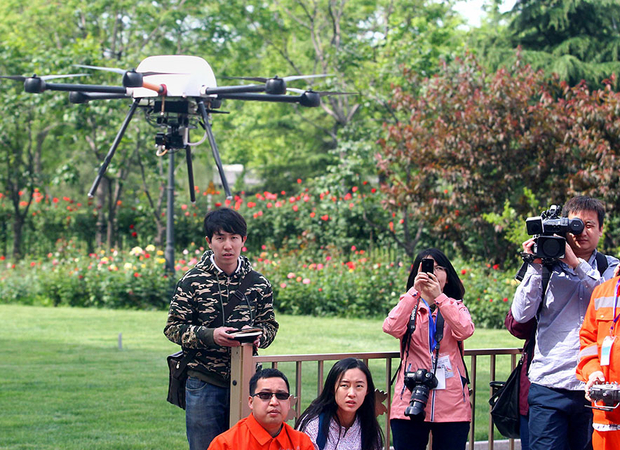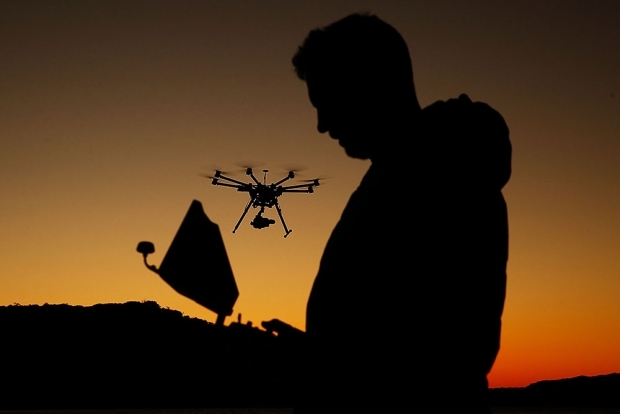A tech evolution and falling production costs have allowed drones to make the flight off military bases and Hollywood production lots to the hands of ordinary people and government agencies.
It has become routine to see these small unmanned aerial vehicles used for amateur photography, rescue efforts, environmental inspection, geographical surveys, and more.
Caixin Media
06.04.15
China Uses Drones to Monitor Pollution Problems from Above
Over about three decades, drones have gone from a cutting-age technology in labs that served military or academic needs to an affordable device equipped with various applications for civilian use. This means that a huge market for civil use of drones is about to soar, and several Chinese companies, including DJI Innovations, XAircraft, and Ehang Technology Co., are taking the lead and getting the attention of investors in the process.
But the business is booming in a regulatory grey area—like many new industries in China, such as car-hire mobile applications—meaning manufacturers are flying in somewhat darkened skies. They are trying to answer a range of questions, such as where the government will set regulatory boundaries for drone use and where the technology is headed.
Flying High
Frank Wang Tao says he has been a fan of robotics and remote control devices since childhood. After he graduated from college in 2006, he founded DJI in Shenzhen, a city in southern China, never expecting that one day the company would be hailed by investors as the Pearl River Delta’s answer to Apple Inc.
DJI has focused on developing drones equipped with cameras that can take high-definition video and photos for commercial use. Its first move was to roll out models priced under U.S.$1,000 that can be controlled by smartphones and tablets.
DJI reported sales of 3 million yuan in 2010, and the figure surged to 800 million yuan in 2013. The company said it supplied 70 percent of the world’s civilian drones in 2015 and sales revenue for the year is expected to hit 6.2 billion yuan.
The company said its products have been used in a range of sectors, including film production, photography, agriculture, rescue, real estate, energy, wildlife protection, and more.
A rival company called XAircraft was founded, with a focus on agriculture business, in 2007 by former Microsoft technician Peng Bin and two partners. Since 2011, the company has been making units that can spray pesticide.
XAircraft has also partnered with courier firms so drones can deliver packages. Gong Qin, another founder of XAircraft, said the company’s drones make 500 trips every day between the cities of Huizhou and Dongguan, in the southern province of Guangdong. The delivery drones can travel up to 100 kilometers between delivery hubs and carry a load of up to 1 kilogram (2.2 pounds).
This buzz has gotten the attention of investors from around the world. In May, DJI got a U.S.$75 million investment from Accel Partners, which was an early backer of the social media giant Facebook and Dropbox, a data storage and transfer service. Few details about the deal were released, but analysts estimated that the deal valued DJI at around U.S.$10 billion.
In September, XAircraft got a U.S.$20 million investment from the Shanghai-based venture capital firm Chengwei Ventures LLC, and Ehang Technology raised U.S.$10 million from GGV Capital in December.
Suppliers have also seen business boom. Beijing Power Vision Technology Ltd., which provides drone control systems and data services, secured an investment of 30 million yuan in September 2014 from Beijing Jiaxun Feihong Electrical Co. Ltd. Then in January, Zero UAV (Beijing) Intelligent Technology Co., a leading provider of aerial photography tools, got 50 million yuan from Shenzhen Rapoo Technology Co.
Expanding Horizons
Unmanned aerial vehicles have been used for surveying and mapping purposes in China since the early 1980s, but civilian use has been limited. That changed in 2011.
Gong Qin, founder of XAircraft, said the market is now thriving because manufacturing costs are falling and smartphone technology is rising. For one thing, he said, the cost of the Global Positioning System module used in drones has tumbled to U.S.$4 from U.S.$400.
Gong said the rising labor costs in many industries have also created business opportunities for drone makers, whose devices are cheaper alternatives than hiring deliverymen or power grid inspectors.
Li Zhiyuan, the strategic cooperation director at Ehang Technology, said drone use was very limited in the past because the equipment was big, expensive, and poorly performing. But in recent years, the costs of sensors and other major parts have declined significantly and supply chains have improved. The devices are also getting easier to use. Civilian drones can be divided into professional and consumer versions. The first type can carry more and fly longer, attributes that help meet the demands of academic research and other operations. Consumer drones, which usually have multiple rotors, have more limited capacities.
The market information provider Analysys said that while the consumer market is growing quickly, the professional market is quiet. Analysys said costs for drone research and technology standardization remain high, and the sector faces challenges related to flight control and battery and communication technology.
The Next Battlefield
Employees of several drone makers agreed that the next task for the industry is making smaller and lighter units that better integrate technologies.
Another challenge is to improve drones’ ability to avoid obstacles, which requires better design. Major drone makers are using ultrasound and infrared sensors to help drones monitor obstacles during flight, but the results have been unsatisfactory. “There hasn’t been a good solution globally,” Gong said.
Companies including Qualcomm Inc. and DJI are studying visual obstacle avoidance systems that would enhance the capacity to detect and avoid obstacles during high-speed flight. But these systems mean more equipment, thus limiting carrying load and presenting other problems.
Industry experts said the future for drones is to get smarter. Zhao Jie, the CEO of Beijing Yidao Technology Co., a developer of millimeter-wave radar, said drones should become flying robots that can complete sophisticated tasks in the air.
The development of drones is comparable to smart control systems in automobiles, she said, the difference being the drone industry lacks a clear development roadmap, tech standards, and regulation.
Regulations for the new technology have not been developed in many countries. In February, the U.S. aviation regulator proposed rules that would require users of unmanned aircraft to obtain special certificates. Units would be limited to speeds of less than 45 meters per second and altitudes of about 150 meters. In late June, the U.S. state of Florida banned the use of drones for surveillance.
China has not issued a specific law on drones, though reports have speared in state media that the authorities are studying rules on airspace and operations.
DJI has tried to get ahead of the situation. On July 15, it announced it appointed the U.S. lawyer Brendan Schulman as the company’s deputy president of policy and legal affairs. Schulman is known as a “drone lawyer” in the United States because he successfully defended the first plaintiff in a federal case involving the operation of a commercial drone.
“The next few years will be critical for the legislation for drones,” Wang said. “So the DJI needs a guide to help with policy and the legal area.”




